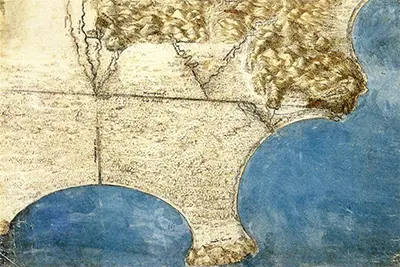Hundreds of years before digital imagery would be able to do the same, before film directors would set up tracking shots able to take us around cliffs and coasts, before Google Maps and the luxury of space satellite imagery, we had da Vinci’s innate ability to capture our imagination with the precursor of these images.
Aerial perspective is a technique da Vinci had used to fine effect in his works previously, but typically these focused on people rather than landscape/ geography.
The attention to detail in this case is beyond impressive; you can clearly see contours representing rivers, and subtle bumps representing ridges purposely placed in certain parts of the surface, giving it an authentic, realistic feel, at a time when the public weren’t accustomed to seeing this perspective shown in such a rich, visual style.
Yet there is still more to this image than what first meets the eye. Looking towards the larger mountain ridges, then to the jagged edge protruding from the bottom right, and finally backing up to once again observe the work in full wide perspective, one may notice certain other images popping up within the scene.
The jagged cliffs to the far right of the main mountain range appear to have the image of what could be a lion, a bear, or even a bearded man in contemplation; their long mane of hair stretching out behind, forming the mountains ridges we observe further up and to the left. Protruding from the bottom right of the image then seems much more like a large foot, most closely resembling that of a bear.
Looking to left-centre, where the jagged mountains come to rest on the left side, one may see what could almost be the squashed head of a goat, with its protruding nose and horns vaguely visible. A victim, perhaps, of the larger beast who dominates the piece with authority.
That the painting is called Bird’s Eye View of Sea Coast – rather than just, say, View of Sea Coast – is likely a reference to the undercurrent of animalistic nature in the overall piece. Like a true genius artist, though, da Vinci leaves his work open to this viewing as well as a humble, plain viewing – that of, simply, a normal view of the sea coast, from a bird’s point of view.
That alone is enough to make the piece fascinating.
n this sense I wonder if, in modern times, da Vinci may have made a fine film-maker himself. With his imagination, sense for metaphor, visual clarity, and an impeccable attention to detail, all of which are perfectly displayed here in Bird’s Eye View of Sea Coast, he would surely have been considered a genius whatever era he’d lived in.


